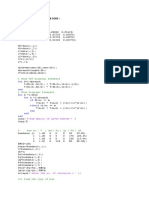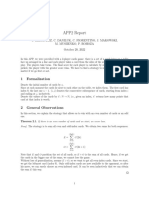Coding of Direct Stiffness Method
Uploaded by
grabspCoding of Direct Stiffness Method
Uploaded by
grabsp%Coding of direct stiffness method
%Taking input
n=input('Enter number of nodes\n');
ne=input('Enter number of springs or elements\n');
nca=input('Enter the nodal connectivities in a form of matrix\n');
k=input('Enter the stiffness of the springs as an array\n');
nf=input('Enter number of forces\n');
f=input('Enter node number & force values as a matrix\n');
nr=input('Enter number of restraints\n');
nre=input('Enter node number of corresponding restraints as an array\n' );
%Creation of the global matrix
kg=zeros(n);
for i=1:ne
ke=[k(i) -k(i);-k(i) k(i)];
n1=nca(i,1);
n2=nca(i,2);
kg(n1,n1)=kg(n1,n1)+ke(1,1);
kg(n1,n2)=kg(n1,n2)+ke(1,2);
kg(n2,n1)=kg(n2,n1)+ke(2,1);
kg(n2,n2)=kg(n2,n2)+ke(2,2);
end
%Creation of force vector matrix.
kg_original=kg
fg=zeros(n,1);
for i=1:nf
n1=f(i,1);
fg(n1)=fg(n1)+f(i,2);
end
%Imposition of boundary conditions.
for i=1:nr
n1=nre(i);
kg(n1,:)=0;
kg(:,n1)=0;
kg(n1,n1)=1;
end
%Solution of global matrix.
U=inv(kg)*fg;
for i=1:n
fprintf('\nDisplacement of node %d = %fmm\n',i,U(i,1));
end
%Finding the reaction forces.
for i=1:nr
n1=nre(1,i);
R(n1)=0;
for j=1:n
R(n1)=R(n1)+kg_original(n1,j)*U(j,1);
end
fprintf('\nReaction at node %d=%f Newton\n',n1,R(n1));
end
%Finding the force on each spring.
for i=1:ne
k1=k(1,i);
n1=nca(i,1);
n2=nca(i,2);
n3=U(n1,1);
n4=U(n2,1);
F=k1*(n3-n4);
fprintf('\nForce on element %d = %f Newton\n',i,F);
end
You might also like
- Bharathidasan Engineering College: Department of Electronics & Communication EngineeringNo ratings yetBharathidasan Engineering College: Department of Electronics & Communication Engineering71 pages
- % This Program Prints The Power Flow Solution in A Tabulated Form % On The Screen. % %CLCNo ratings yet% This Program Prints The Power Flow Solution in A Tabulated Form % On The Screen. % %CLC5 pages
- Matlab Program For Method of Bisection Method When No. of Iterations Is GivenNo ratings yetMatlab Program For Method of Bisection Method When No. of Iterations Is Given27 pages
- NND Nel Nne Nodof Eldof Nne Nodof: For For IfNo ratings yetNND Nel Nne Nodof Eldof Nne Nodof: For For If4 pages
- %PN Sequence Generation %Auto-Correlation Property of PN Sequence %generating Mapped PN SequenceNo ratings yet%PN Sequence Generation %Auto-Correlation Property of PN Sequence %generating Mapped PN Sequence6 pages
- Matlab Code:: % Spectrum Analysis by DFTNo ratings yetMatlab Code:: % Spectrum Analysis by DFT3 pages
- Matlab Code For Basic DSP Signals MATLAB PROGRAM TO DISPLAY THE PROPERTIES OF DISCRETE FOURIER TRANSFORM (DFT)No ratings yetMatlab Code For Basic DSP Signals MATLAB PROGRAM TO DISPLAY THE PROPERTIES OF DISCRETE FOURIER TRANSFORM (DFT)16 pages
- Function: (W - ST, ST, X - ST) Kruskal (X, W)No ratings yetFunction: (W - ST, ST, X - ST) Kruskal (X, W)4 pages
- Discrete Signal Processing Experiment 5 CodeNo ratings yetDiscrete Signal Processing Experiment 5 Code3 pages
- 11.instructional Manual Sample Program OutputNo ratings yet11.instructional Manual Sample Program Output30 pages
- Experiment Name: Impulse Response by Difference EquationNo ratings yetExperiment Name: Impulse Response by Difference Equation2 pages
- Experiment Name: Impulse Response by Difference EquationNo ratings yetExperiment Name: Impulse Response by Difference Equation2 pages
- Part-A Experiments Using Matlab: DSP Lab ManualNo ratings yetPart-A Experiments Using Matlab: DSP Lab Manual40 pages
- VTU DSP Lab Manual 5th Sem E C Matlab Programs and CCS Studio Programs50% (2)VTU DSP Lab Manual 5th Sem E C Matlab Programs and CCS Studio Programs63 pages
- Student Solutions Manual to Accompany Economic Dynamics in Discrete Time, secondeditionFrom EverandStudent Solutions Manual to Accompany Economic Dynamics in Discrete Time, secondedition4.5/5 (2)
- Chapter 2 - Numerical Methods For Parabolic PDENo ratings yetChapter 2 - Numerical Methods For Parabolic PDE6 pages
- PDF The Algorithm Design Manual 3Rd Edition Steven S Skiena Ebook Full ChapterNo ratings yetPDF The Algorithm Design Manual 3Rd Edition Steven S Skiena Ebook Full Chapter64 pages
- Interpolation and Polynomial ApproximationNo ratings yetInterpolation and Polynomial Approximation12 pages
- Class IX - Polynomials - Assignment - Type - INo ratings yetClass IX - Polynomials - Assignment - Type - I5 pages
- Variable Separable and First Order Homogeneous DENo ratings yetVariable Separable and First Order Homogeneous DE16 pages
- Cell Name Original Value Final Value IntegerNo ratings yetCell Name Original Value Final Value Integer5 pages
- Solutions of Equations in One Variable The Bisection MethodNo ratings yetSolutions of Equations in One Variable The Bisection Method17 pages
- Deep Learning - IIT Ropar - Unit 7 - Week 4100% (1)Deep Learning - IIT Ropar - Unit 7 - Week 45 pages
- chapter 5 Transportation and Assignment ProblemsNo ratings yetchapter 5 Transportation and Assignment Problems49 pages
- Design & Analysis of Algorithms Lab Manual100% (1)Design & Analysis of Algorithms Lab Manual84 pages

























































































